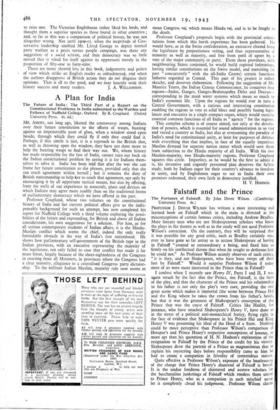The Future of India : The Third Part of a
Report on the Constitutional Problems in India submitted to the Warden and Fellows of Nuffield College, Oxford. By R. Coupland. (Oxford University Press. 6s. 6d.)
A Plan for India
MR. AMERY, not long ago, likened the controversy among Indians over their future constitution to the efforts of wasps, buzzing against an impenetrable pane of glass, when a window stood open beside, through which they could fly if only they could find it Perhaps, if this simile is just, it is a reproach to the British that, as well as throwing open the window, they 'have not done more to help the buzzing wasps to find their way out. We, whom history has made responsible for the fate of India, cannot turn our back on the Indian constitutional problem by saying it is for Indians them- selves to solve it. India has been told that after the war she can frame her future constitution as she pleases, provided only that she can reach agreement within herself ; but it remains the duty of British statesmanship to help her to reach that agreement, not only by encouraging it by all opportune tactical means, but also by offering, from the wells of our experience in statecraft, plans and devices on which Indians may agree more readily than on the traditional forms of parliamentary democracy which we have offered in the past. Professor Coupland, whose two volumes on the constitutional history of India and her current political affairs give us the indis- pensable background for such an attempt, has now completed his report for Nuffield College with a third volume exploring the possi- bilities of the future and expounding, for British and above all Indian consideration, his own suggestions for a solution. For him,. as for all serious contemporary students of Indian affairs, it is the Hindu- Muslim conflict which seems the chief, indeed the only really formidable obstacle in the way of India's free nationhood. He_ shows how parliamentary self-government of the British type in the Indian provinces, with an executive representing the majority of the legislature, not only failed to ease that conflict but made it far more bitter, largely because of the short-sightedness of the Congress in exacting from all Ministers, in provinces where the Congress had -a clear majority, allegiance to a centralised Congress party dictator- ship. To the militant Indian Muslim, majority rule now seems to mean Congress raj, which means Hindu raj, and is to be fought to the death.
Professor Coupland's proposals begin with the provincial consti- tutions from which this harsh -experience -has been gathered. He would have, as in the Swiss confederation, an. executive elected from the legislature by proportionate voting, and thus representative of minority as well as majority, and free from peril of upset by a vote of the major community or party. From these provinces, with neighbouring States conjoined, he would build regional federations, having similar constitutions on the Swiss model, and exercising (in part " concurrently " with the all-India Centre) certain functions hitherto regarded as Central. This part of his project is rather sketchy, and deserves elaboration. Following the suggestion of Mr. Maurice Yeatts, the Indian Census Commissioner, he conceives four regions—Indus, Ganges, Ganges-Brahmaptftra Delta and Deccan— corresponding to the maid water systems which mean so much to India's economic life. Upon the regions he would rear in turn a Central Government, with a curious and interesting constitution enabling the regions to vote as solid blocs and possibly fusing legis- lature and executive in a single compact organ, which would exercise essential common functions of all India as " agency " for the regions.
This complex scheme is of course aimed, not only at the devolu- tion of powers, which is essential for sound administration in so vast and varied a country as India, but also at overcoming the paradox of India's need for constitutional unity, at least for purposes of defence with everything that that implies, in face of the equally imperious Muslim demand for separate nation status which would save them from subjection to the Hindu majority of all India. With his two Muslim-majority, two Hindu-majority regions, Professor Coupland squares this circle. Imperfect, as he would be the first to admit it is, his inventive and cogently presented plan deserves the fullest study, both by Indians eager for their country's advance to freedom in unity, and by Englishmen eager to see in India their own promises redeemed, their own faith in democracy justified.


























 Previous page
Previous page